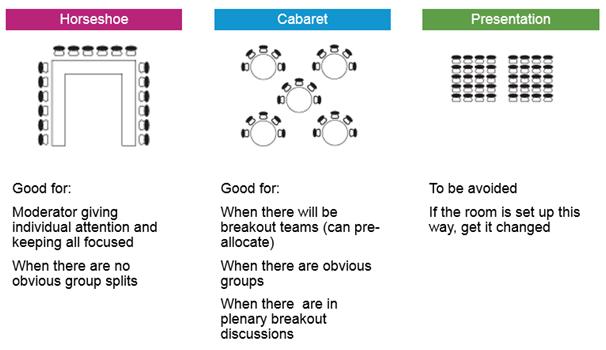Conducting impactful workshops

Kelly Price shares her top tips on how to establish and conduct an impactful workshop.
In this digital day and age, with time at a premium and multi-tasking the new working norm, finding the time to gather people in a room for an in-person workshop is an increasingly difficult mission. Thus, when you are able to make these stars align, you want to ensure it is as useful and productive an experience as possible. You want attendees to be glad that they took the time away from their computers and phones, and that what was accomplished during that time, was something they could not have learned or accomplished on their own.
By incorporating five simple principles, you can ensure that everyone attending your workshop leaves the room in a better place than when they entered – and most importantly, you can be sure they are glad that they came.
1. Establish the atmosphere
Introductions through ice breakers
Your introductions will set the tone of your time together. It is important to make sure that you take charge early. A good way is to start by leading with an ice-breaker introduction. This allows everyone – even if they already know each other – to introduce themselves with a bit of new information.
A successful introduction ice-breaker is the alternative career version - "My name is Jane, and if I weren't in sales, I would be a photojournalist because I love photography and travel." In addition to reminding everyone of their current roles, it provides information about people's interests beyond work that can help members get to know each other on a more personal – and fun – level.
2. Set the scene
Road map
Once the ice is broken and you are established in your leadership role, it is always good to remind people of why they are there. You wouldn't start out on a journey without a destination in mind, and a workshop is certainly a mental journey that you lead participants on. It may sound obvious, but stating the objective or 'problem' that the team is there to address helps get everyone on the same page and pointed in the right direction.
Once the destination is clear, providing a written 'road map' of the day in terms of an agenda, either on individual handouts or on a flipchart, helps everyone see the 'big picture'. It helps them know how time is going to be allocated, and how the different parts fit together to help them reach the destination. It also helps them know when the breaks are coming up so that they are able to pace themselves in terms of checking email or taking calls – and when they can look forward to the all-important coffee and treats!
3. Get buy-in
Individual destinations
While everyone may agree on the destination, different participants may be looking to get different things out of the workshop – their own individual 'destination'. We can do this via a process called 'evidence procedure': Go around the room and ask everyone's objectives for coming to the workshop. It's helpful to write each person's objectives down next to their name on a flip chart. This helps participants feel that the workshop is about them and what they will get out of it, which leads to buy-in. Even if someone is not there necessarily voluntarily, reminding them that they have something to gain personally is a good way to bring them into the fold. It can also help other members to see what their teammates are looking to get out of the session – it helps them expand their ideas of how your workshop can benefit them, which further increases their enthusiasm and participation level.
Evidence procedure
Once individual objectives are listed out, go around the room again and ask each person what their 'evidence' will be that will let them know they have arrived at their individual destination. For example, Jane may be attending to learn new ways to engage her customers, and she will know that she has arrived at this destination if she leaves the room with two new ways to initiate conversations with new clients. At the end of the session, you can now go around the room again and ensure that everyone has met their personal goals for the meeting. This helps each participant verbally acknowledge that they have accomplished something during your time together.
"You wouldn't start out on a journey without a destination in mind, and a workshop is certainly a mental journey that you lead participants on."
Rules of conduct
In any gathering of people, especially where ranks or roles are different, it is good to state up front what the rules of conduct are. Are questions allowed throughout? How will disagreements be dealt with / is the goal is to arrive at a unanimous solution? Will the learnings eventually be shared with a wider audience or is the discussion meant to be kept among participants? It is best to come to agreement on each of these things before you dive into the nitty-gritty of your meeting.
Leading from beside
Wherever possible, it is good for the workshop moderator to "lead from beside". This doesn't mean giving up a leadership role; rather, it means facilitating discussion among your participants as much as possible. Your goal is to leave them with new knowledge. The best way to get participants there is to help them arrive at a conclusion by themselves. When people make the logical leaps themselves, better memories are formed, and the knowledge tends to stick with them. Thus, asking rather than telling not only ensures better participation (and therefore buy-in), it also means that your audience is more likely to be able to remember what they learn and put it to future use.
Break-outs
Sociologists have long noted that when groups of more than five people gather, conversation tends to fragment – either discussions break into smaller groups, or the dominant individuals lead the discussion and quieter individuals tend to listen. A useful technique you might be able to employ in order to ensure equal participation is to break-out participants into smaller groups. Divide people up into smaller teams of 3–4 and have them work on tasks together. This helps ensure that even the quieter members feel that they have a space in which they can voice their thoughts and opinions. The more member participation, the richer the output of your workshop, and the stronger the buy-in.
"Making sure the basics are covered is critical to ensuring that your workshop starts out on the right note."
4. Don't forget the 'little things'
Arrive early
It may sound pessimistic, but it is best to employ Murphy's Law and assume that if it can go wrong, it will. Arriving early helps ensure that you have time to figure out what has already gone wrong so that you can fix it.
Check your equipment
Is the projector working? Did every participant get the right materials? Is the room big enough to hold everyone? Making sure the basics are covered is critical to ensuring that your workshop starts out on the right note.
Configure the room
Depending on how much space you have, you may be able to configure your room in a way that will help ensure better participation. If large group discussions are key, then a horseshoe ring set-up may help. If you are conducting break-out groups, making sure that there are places where small teams can gather is key.
Conduct a walk-through
What do brides, Broadway actors and good presenters have in common? They rehearse! It is always a good idea to walk through the day sequentially before your meeting starts, even if just mentally. You may realize that there are some logistical gaps that need to be covered – has anyone ordered snacks for the coffee break? What about the flip charts – have they been set up? Are there crayons or colored pencils on the table for your creative exercise? A mental walk-through can help avoid embarrassing pitfalls.
5. Stay flexible – and have fun!
Create contingencies
No matter how much you plan and rehearse, the one thing you can count on is that things will happen to throw you off track. Someone arrives late. One discussion takes longer than planned. Your schedule gets thrown off-kilter.
"...you may be able to configure your room in a way that will help ensure better participation."
No problem – because you are flexible. Figure out beforehand those parts of the discussion that can be covered briefly or skipped altogether if you are running behind. The worst thing is to run over – which is disrespectful of people's time – or to appear flustered, which can lessen your impact. By having a plan in place, you can stay calm and flexible, finish on time – and have fun in the process!
Energizing interaction
To keep energy and engagement high throughout the day, build in 10-minute exercises which encourage creative thinking and moving around the room. Having participants write on post-it notes and then organizing on a wall – "Who would you like to have been born as", "3 things you hate" – allows for a quick energizing break in the day and participants can then bond over shared opinions.
Incorporating the above five techniques into your next workshop, will ensure you are seen as a confident, knowledgeable, flexible, moderator offering clear, objective-focused content. Your audience will appreciate that they have taken the time to attend and learn something relevant, knowledge which they can now extend to apply in a real-world setting.
Now you're ready!
Now you are familiar with the principles of excellent workshop moderation:
1. Establish the atmosphere
2. Set the scene
3. Get buy-in
4. Don't forget the 'little' things
5. Stay flexible – and have fun!
By incorporating the above five techniques into your next workshop, you will ensure you are seen as a confident, knowledgeable, flexible, moderator offering clear, objective-focused content. Your audience will appreciate that the time they invested with you was well-spent, and you will have the satisfaction of having led them on a successful mental journey!
About the author:
Kelly Price is Head of TPSi's Oncology Specialist Group at THE PLANNING SHOP international.
With a background in strategic consulting, she has over 10 years' experience in oncology-specific research across the vast spectrum of tumor types.
You can contact Kelly on +1 215 680 8720 or at kelly.price@planningshopintl.com
What is your top tip on running a workshop?













